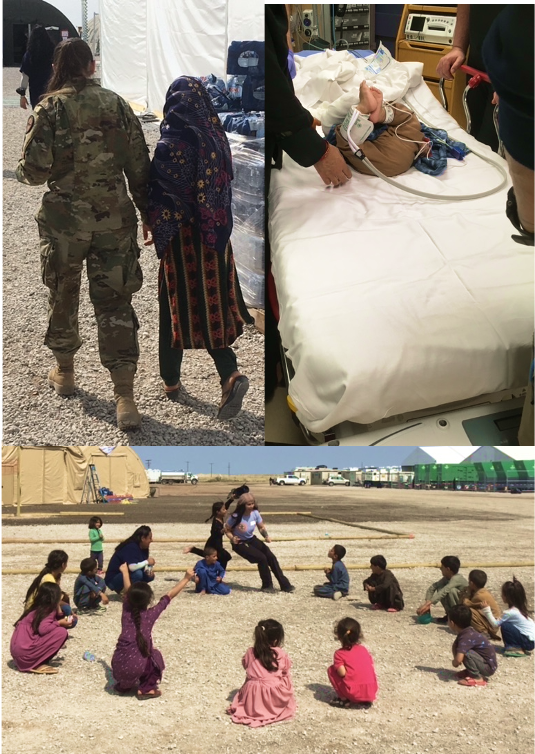By Nellie Bly
Prologue: This was written over the course of several deployment periods of one to three weeks. Aman Omid Village on Holloman Air Force Base closed at the end of January 2022, having in-processed and placed 16,000 Afghani evacuees. All but eight survived. For the five months it existed, and adjusting for average population, the Village death rate was about one-third that of the general U.S. population.
There were about 7,200 people in this improvised “Village” in the middle of the Tularosa Basin of the Chihuahan Desert, home to White Sands Missile Range and National Park, the Malpais Lava Fields, and the Trinity Site, where the world’s first nuclear detonation turned the desert sand to glass.
These flatlands lie between the Oscura and San Andres ranges to the west, and the Sacramento Mountains to the east, home of Smokey Bear and the range wars with Billy the Kid and the Regulators.
Forty years ago, at age 17, I started my emergency medical services career on the Mescalero Apache Reservation, nestled in the Sacramento Mountain range. Participation in the “closed” Emergency Medical Technician-Basic class required approval from the tribal elders. Coincidentally, I ended up getting my first EMS job in nearby Ruidoso, once part of Pat Garrett’s jurisdiction as Sheriff of Lincoln County.
This “Tulie” Basin was also home to Holloman Air Force Base, host of this refugee camp. Among the 7,000 or so initial refugees were about 800 pregnant women. Another 3,200 or so were children under 12 years, with most of those under age eight, and about 1,300 younger than three. These were among the first evacuees as the Taliban closed in.
I was one of four mission leads running three paramedic teams staffed 24-7 under federal contract, each with one man and one woman, responding to the EMS needs of the refugees, and occasionally civilian contractors and service members. Leads were responsible for team readiness and response, triage, coordination, and personnel issues.
The Air Force named the camp Aman Omid Village, and we hosted “villagers,” not refugees or detainees. The slogan on the T-shirts worn by medical airmen was “Be Our Guest.” Everyone here was free to leave, though in leaving, refugees would abandon the transitional support and resettlement programs offered and coordinated by the U.S. State Department and other agencies. The main base gate on the southern side was very close to Mexico, and regularly patrolled by the U.S. Border Patrol. No one walked away.
Fluor International was the prime contractor with the State Department, and our team, from Motion Picture Set Medics, was subcontracted by Fluor. We were largely independent, but coordinated with the medical command and resource structure on location under the Air Force and Alamogordo’s civilian system.
MPSM has extensive experience providing paramedic services in austere environments on sets and on location for major film and TV productions. One of the paramedics who worked here in the first days was later the set medic for the Santa Fe area production of “Rust,” and dealt with the victims of Alec Baldwin’s gun mishap.
This was an unusual assignment for MPSM. The entertainment industry does not involve many children or pregnant women. On this gig, we were running what was primarily a pediatric and obstetric critical care transport service. We delivered babies. We saved and lost tiny ones, and saved and lost physically and mentally traumatized kids and adults.
Not everyone survived. Among the first wave of evacuees were two babies with disease severity and complications that proved too dire to survive, despite our efforts and air evacuation to pediatric specialty centers.
We took care of one 9-month-old three times, managing fluid balance and fever with intravenous lines, steroids, and antibiotics, finally getting her airlifted to El Paso Children’s Hospital. She had C. difficile, astrovirus, adenovirus, sapovirus, and giardia. This constellation of disease is never seen in the first world. She also had old bruises that were suspect until we learned they were from being thrown into the Kabul airlift plane by her mother, who was herself grabbed by others and pulled into the plane as it taxied to liftoff. Mom saw her husband and five other children gunned down.
The Languages there were Pashto, Dari, Farsi, and two tribal dialects incomprehensible to the others. The single men lived in a tent of their own. Families were in the others. There were no single adult women; they were housed at different bases. But we had plenty of widows.
Editor’s note: Vashon Loop substack subscribers (https://vashonloop.substack.com) with paid subscriptions have early access to the full content of this article. Join the Vashon Loop Substack today!

